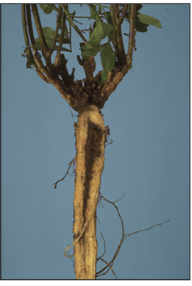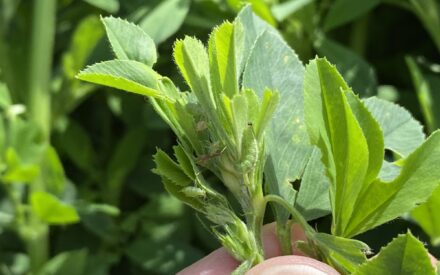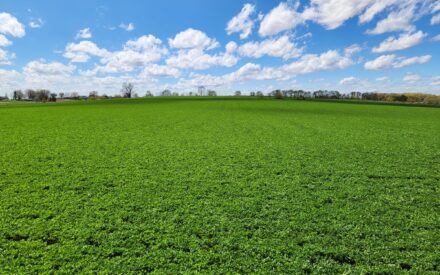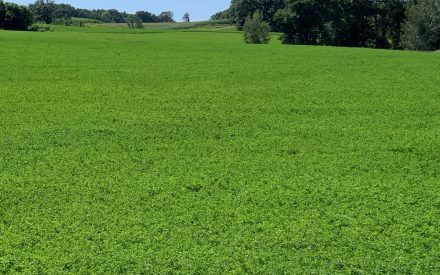Winter 2024-25 is in the books and can be chalked up as another installment in a string of abnormal winters we’ve gotten so far this decade. Substantial snowfalls were few and far between, sub-zero cold was relatively common, and winter annuals, fall seeded perennials, alongside established alfalfa stands entered a challenging overwintering situation.
Unsurprisingly, I’ve heard a lot about farmers around Wisconsin intending to rotate out rough-looking alfalfa stands at least in part due to winterkill. This may not be a bad idea, but it’s helpful to know the process of objectively evaluating an alfalfa stand’s condition to know if it is good enough to keep. Then we can tackle other subsequent management questions with confidence.
Evaluating alfalfa quality in spring and fall
Alfalfa stand quality can (and should!) be evaluated in both spring and fall. Fall evaluations have the advantage of giving us more time to make management decisions for the following growing season, such as fertilizer application, spring herbicide strategies, and crop sequencing.
However, for winter kill, a spring evaluation is also necessary to truly judge the status of our alfalfa fields. Luckily, the same aspects are evaluated for both seasons. One of the most obvious signs of winter injury in alfalfa is slow green up in the spring. If neighboring fields are starting to grow, and one is still brown, it’s time to check for injury or death.
Assessing alfalfa for winter kill
Wisconsin research has supported utilizing stem counts along with root and crown health assessment in place of plant density to properly evaluate a stand.
Stems
To conduct a stem count, select 3 representative areas in a field and mark out a 2-foot square section in each using a 17” x 17” square comprised of ½” PVC tubing, or a 19” diameter ring.
In these squares, count the number of stems over 2” tall, then divide by two to get stems per square foot.
Add the total number together and divide by 3 to obtain the average across the 3 representative sites. A good rule of thumb is that with any number above 55, stem density is not the limiting factor for yield that year. Less dense stands are worth considering for replacement. This is where plant health qualities come into consideration.
Roots
Now, break out the shovel. Select about 3 representative spots in a field to dig down to at least 6” depth to obtain a good plant sample to evaluate both the crown and root conditions.
Winter killed roots will be soft, stringy, and gray or brown, and you may be able to squeeze water out of them.

Crown
Shoots of differing heights indicate some fall-formed buds were killed off during winter and needed to regrow from scratch.
Asymmetrical green growth from the crown may also be a sign that only a portion of the plant has survived. This is another reason stem counts are more reliable than plant density.
Now that you have all this information, you can start to make a more informed decision on stand retention. If you have at least 55 stems per square foot, on average, you can expect a continued return on the investment you made by seeding that field down for at least another year.
Assessing alfalfa stand quality in spring without stem visibility
If you are assessing early enough in spring and stems are not visible, use the following as a guide:
- A stand seeded last year should have at least 12-20 plants per square foot. If this stand is thinner than that, you can reseed without autotoxicity concerns, as this would be only a 1-year-old stand.
- Stands older than 1 year that do not have at least 5-6 plants per square foot should be terminated and rotated to a non-alfalfa crop.
- When you get below any of these thresholds AND if more than 30% of a field is affected by root rot to the point that ½ the diameter of these roots is discolored, it’s time to develop alternative plans for that field.
What to do if alfalfa stands are in poor quality
There are several alternatives to manage an alfalfa stand after winterkill damage.
Overseeding with forage grasses
If you do decide to overseed with a grass forage such as orchard grass, Italian ryegrass, or oats, a general prescription of 40-60 pounds of nitrogen per acre should be considered to assist in establishing these grasses.
Rotating out of alfalfa and taking advantage of N credits
If you are rotating into corn, remember that although an alfalfa field was terminated due to winterkill, the legume nitrogen credits provided by that stand are still very significant. Alfalfa stand density and regrowth height in the previous fall and soil texture are used to determine the nitrogen credits provided to a spring planted corn crop.
The one exception to this is if the alfalfa stand was cut for a first crop of hay before corn is planted. In that case, the stand count conducted after the first hay cutting would be the best estimate of credited nitrogen. Using the chart below, if the alfalfa stand was harvested and had less than eight inches of regrowth and a stand density of three plants per square foot on a medium textured (silt loam or clay) soil, the nitrogen credit for the following corn crop would be 120 pounds of nitrogen per acre.

Source: Laboski, C. & Peters, J., 2012. Click to enlarge.
To dive deeper into the methodologies mentioned in this article, see visual references, obtain fertilizer recommendations for your farm’s soils, and find related resources, refer to the references dropdown below.
References
Cosgrove, D., & Undersander, D. (2003). Evaluating and Managing Alfalfa Stands for Winter Injury. Focus on Forage, 5(8). https://fyi.extension.wisc.edu/forage/files/2014/01/StandEvaluationFOF.pdf
Gildersleeve, R., Undersander, D., & Wood, T. (2003). Seeding into an Existing Alfalfa Stand. Focus on Forage, 5(9). https://fyi.extension.wisc.edu/forage/seeding-into-an-existing-alfalfa-stand/
Laboski, C. (2019). Nitrogen Credits Following Winter-killed Alfalfa. Wisconsin Crop Manager. https://ipcm.wisc.edu/blog/2019/03/nitrogen-credits-following-winter-killed-alfalfa-2/
Laboski, C., & Peters, J. (2012). Nutrient application guidelines for field, vegetable, and fruit crops in Wisconsin. https://learningstore.extension.wisc.edu/products/nutrient-application-guidelines-for-field-vegetable-and-fruit-crops-in-wisconsin-p185
Undersander, D. (n.d.). Assessing Alfalfa Stand Condition in the Spring. https://fyi.extension.wisc.edu/forage/assessing-alfalfa-stand-condition-in-the-spring/
Undersander, D., Grau, C., Cosgrove, D., Doll, J., Martin, N. (2011). Alfalfa Stand Assessment: Is This Stand Good Enough to Keep? https://fyi.extension.wisc.edu/forage/alfalfa-stand-assessment-is-this-stand-good-enough-to-keep/#:~:text=Assessing%20Crown%20and%20Root%20Health&text=Dig%20the%20plants%20from%20three,in%20the%20crown%20and%20root.
Updated: April 8, 2025
Reviewed by: Dan Marzu, Kevin Jarek, and Marta Moura Kohmann

 ▶ Forage Insect Pest Update
▶ Forage Insect Pest Update ▶ Determining the Value of Standing Forage
▶ Determining the Value of Standing Forage First crop insect scouting in alfalfa
First crop insect scouting in alfalfa


